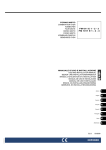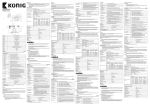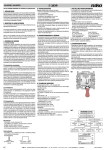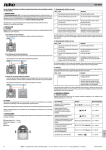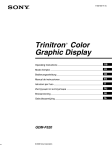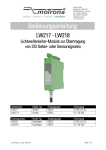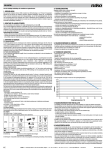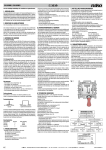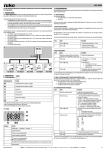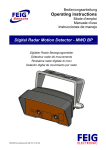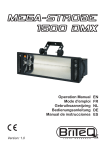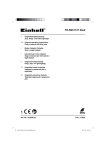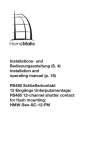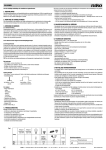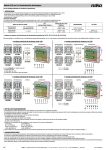Download Technische Handleiding
Transcript
05-728 Lees de volledige handleiding vóór installatie en ingebruikname. Bewaar deze handleiding zorgvuldig voor later gebruik. 1. BESCHRIJVING Intensiteitsregeling (‘dimming’) van alle regelbare resistieve en inductieve belastingen, met uitzondering van fluorescentielampen en capacitieve belastingen (elektronische transformatoren...). Resistieve belastingen: gloeilampen, 230V-halogeenlampen... Inductieve belastingen: ferromagnetische (gewikkelde) transformatoren Resistieve en inductieve lasten mogen gemengd worden. 2. WERKING EN GEBRUIK De dimmer 05-728 werkt met een triac (fase-AANsnijding). De dimmer wordt bediend op afstand door middel van één of meerdere N.O.-contacten (170-0000X). Een korte druk op de toets schakelt het licht aan of uit (werkt als een schakelaar). Een langere druk op de toets beveelt de dimwerking. De regeltijd (gemeten bij gloeilampen) van een volledige cyclus bedraagt ± 4s. (min. - max. - stop). Een hernieuwde druk keert de dimrichting om. De tijd tussen twee bedieningen moet min. 500ms. bedragen (zie fig.1 en 2). De druktoetsen worden via een interne optocoupler met de dimmer verbonden om storingen te vermijden. Een lamp die aangesloten is via dimmers kan niet tot de max. lichtintensiteit gedimd worden. De lichtopbrengst zal steeds kleiner zijn dan die van een identieke lamp die rechtstreeks op het net aangesloten is. De dimmer is voorzien van een systeem dat knipperen vermijdt bij plotse daling van de netfrequentie. ‘Frequentiedips’ tot 3Hz worden opgevangen door een vermindering van de lichtintensiteit. De dimmer kan naar max. geregeld worden bij de eerstvolgende bediening. Na inschakeling van de netspanning kan het -afhankelijk van de netfrequentie- tot 20s. (40Hz) duren voor de dimmer bediend kan worden. 2.1. Lokale bediening De dimmer is voorzien van een lokale bedieningstoets op de voorkant. Deze toets heeft dezelfde functie als de toetsen die op afstand verbonden worden en kan gebruikt worden om de dimmer lokaal te testen of om de geheugenfunctie (zie 2.3.) in te stellen. 2.2. Afstandsbediening Afstandsbediening door N.O.-contacten (niet verlicht). Kort drukken voor inschakelen/uitschakelen. Lang drukken voor opdimmen/neerdimmen. Bij lang drukken wordt na elke onderbreking de richting omgekeerd (opdimmen -> stop -> neerdimmen -> stop -> opdimmen -> ...). Eens de maximumintensiteit bereikt is, blijft het niveau onveranderd, ook al wordt de druktoets nog langer ingedrukt. Het laatste niveau wordt al dan niet in een geheugen opgeslagen (zie 2.3.). Tot 30 N.O.-contacten (170-0000X) kunnen in parallel aangesloten worden (max. afstand 50m). Verschillende configuraties zijn mogelijk (zie schema's). 2.3. Geheugenfunctie De dimmer kan zowel met als zonder geheugen gebruikt worden. Zonder geheugenfunctie schakelt de dimmer in op max. lichtsterkte. Met geheugenfunctie schakelt de dimmer bij ingebruikneming in op min. lichtstand. Daarna schakelt de dimmer in op de laatst ingestelde waarde. De dimmer is standaard ingesteld met geheugenfunctie. Om deze functie te wijzigen, volstaat het gedurende 10s. op de bedieningstoets te drukken. Na 10s. daalt de lichtintensiteit van 100% tot 50% om aan te duiden dat de standaardfunctie uitgeschakeld is. Los de druktoets onmiddellijk na deze wijziging in lichtintensiteit. Herhaal deze procedure om de geheugenfunctie weer in te schakelen. Deze functie wordt samen met de laatst ingestelde lichtstand in een permanent geheugen bewaard. Zij gaan bij een spanningsonderbreking niet verloren. In combinatie met Nikobus: Als de dimmer 05-728 samen met het Nikobus-domoticasysteem gebruikt wordt, let er dan op dat de dimmer 05-728 ingesteld is zonder geheugenfunctie. Dit om te vermijden dat de dimmer 05-728 met geheugenfunctie inschakelt als hij na een lange stroomonderbreking opnieuw onder spanning komt. Dit is absoluut niet aan te bevelen in combinatie met Nikobus. 2.4. Beveiligingen Thermische beveiliging: indien de interne temperatuur 120°C overschrijdt, zal deze beveiliging de dimmer uitschakelen. Zodra de temperatuur daalt, is de dimmer weer regelbaar. Softstart: de inschakelstroom wordt elektronisch beperkt. Indien er ontstekingsproblemen zijn door zeer hoge inducties wordt de triac uitgeschakeld. De dimmer herstart automatisch zodra de druktoets bediend wordt. 2.5. Netaansluitingen: bovenaan van links naar rechts Zie schema's. De twee klemmen aan de rechterzijde zijn intern doorverbonden. Draag er tijdens de installatie zorg voor dat de aansluitdraden zich minimaal 5cm van de koelopeningen bevinden. Op geen enkel ogenblik mogen de aansluitdraden de koelopeningen afdekken. Opgelet: voor het inschakelen nazien of alle verbindingen goed aangespannen zijn. Bij onderhoud van de installatie moet men de druk op de klemmen nazien. De dimmer moet in een kast met afscherming geplaatst worden. 2.6. Sturingsaansluitingen: druktoetsbediening Er zijn verschillende configuraties mogelijk: zie schema's: - drukknop naar geregelde fase - drukknop naar de fase: externe draadbrug toevoegen (niet geleverd) 2.7. Koeling De koeling is essentieel voor een bedrijfszeker en veilig gebruik. De dimmer produceert ±0,9% warmte t.o.v. het aangesloten verbruik. Bv. 1.000W verlichting = 9W dissipatie. Zorg voor een aangepaste circulatie van koele lucht t. o. v. het totaal gedissipeerd vermogen. Indien de natuurlijke luchtcirculatie beperkt is, moet er een ventilator in de kast of in het lokaal voorzien worden. Behoud 2cm onderlinge afstand indien meerdere dimmers naast elkaar geplaatst worden. Nominale omgevingstemperatuur: 35°C. 2.8. Ontstoring Storing over de voedingskabels: de ontstoringsgraad beantwoordt aan de Europese standaard (EN55015). 3. WAARSCHUWINGEN BIJ GEBRUIK -Deze toestellen zijn niet geschikt voor het regelen van motoren tenzij de specifieke veiligheidseisen door externe systemen gewaarborgd worden (automatisch herstarten na netonderbreking is in dit geval niet toegelaten). -Opmerking i.v.m. inductieve lasten: als de dimmer aangesloten wordt op gewikkelde transformatoren mogen enkel transformatoren gebruikt worden die geschikt zijn voor dimming. De transformatoren moeten min. 75% belast zijn. -Het verbruik van ferromagnetische transformatoren moet met rendementsverlies vermeerderd worden (bv. rendement 80% = max. belasting 800W). Als het rendement niet gekend is, moet de max. belasting met 20% verminderd worden. -Het gebruik van ringkerntransformatoren kan gebrom veroorzaken. -De dimmer wordt door een bediening van de sturing nooit elektrisch van het net gescheiden. Alle delen, incl. de lampen, blijven onder spanning, ook al is het licht ‘uit’. Signalen die via het net verstuurd worden, kunnen de werking van de dimmer storen. De storing treedt enkel op als dit signaal over het net verstuurd wordt. De dimmer is voorzien van een ingebouwde filter om dit effect te onderdrukken. 4. TECHNISCHE GEGEVENS Voedingsspanning: 230V~ ±10%, frequentie 40 tot 60Hz Afmetingen: H 89 x B 70 x D 54,5mm Gewicht: 0,280kg Voor de regeling van gloeilampen, halogeenlampen 230V~ en Ohmse belastingen (max. 1.000W, min. 40W). Voor halogeenlampen zeer lage spanning 12V~, 24V~ enz. met gewikkelde transformatoren (E- kern) (max. 1.000VA, min. 50VA) Ingebouwde drukknop voor bediening Meerdere regelpunten door middel van drukknoppen N.O. (170-0000X), max. 30 Thermische overbelastingsbeveiliging met automatische herstelfunctie Mogelijkheid om de laatste lichtintensiteit te bewaren Voorzien van een smeltpatroon F5AH (02- 920- 20), met vlugge werking (volgens DIN 41660 of IEC 127- 2) 2 reservezekeringen ingebouwd Belangrijk: de max. belasting is hoofdzakelijk afhankelijk van de omgevingstemperatuur (zie fig.4). 5. ONDERHOUD Deze toestellen zijn gemaakt voor gebruik in volgende omstandigheden: - een omgevingstemperatuur van 35°C - een niet-condenserende luchtvochtigheidsgraad - een netspanning van 230V Regelmatig nazicht, van op zijn minst het volgende, is aangewezen na volledige uitschakeling van de netvoeding: - druk van de aansluitklemmen - ventilatie Kort <400ms = aan/uit Lang >400ms = stijgen/dalen Max. Min. 3 4 5 6 7 Max. Min. 1 2 3 4 5 6 7 8 9 10 11 12 13 14 15 16 17 18 19 20 21 22 23 24 25 s Omschakeling van functie: Dim op tot max. lichtsterkte en houd de drukknop ingedrukt. Na 10s. max. licht daalt de lichtsterkte tot 50%. Los op dit moment de drukknop (dimmer schakelt uit). De functie is omgeschakeld. Indien men de drukknop niet onmiddellijk loslaat, wordt de functie niet omgeschakeld (dimmer blijft op 50%). De laatste functie blijft behouden na spanningsonderbreking. Voorbeeld: omschakelen van 'zonder geheugen' naar geheugenfunctie. fig.3 Max. 50% Mem. Min. 1 2 3 4 5 6 7 8 9 10 11 12 13 14 15 16 17 18 19 s 6. WAARSCHUWINGEN VOOR INSTALLATIE -- De installatie moet worden uitgevoerd door een erkend installateur en volgens de geldende voorschriften. -- Deze handleiding moet aan de gebruiker worden overhandigd. Het moet bij het dossier van de elektrische installatie worden gevoegd en worden overgedragen aan eventuele nieuwe eigenaars. Bijkomende exemplaren zijn verkrijgbaar via de website of supportdienst van Niko. Op de Niko website is altijd de meest recente handleiding van het product terug te vinden. -- T ijdens de installatie moet rekening gehouden worden met (nietlimitatieve lijst): -- de geldende wetten, normen en reglementen. -- de stand van de techniek op het moment van de installatie. -- deze handleiding die alleen algemene bepalingen vermeldt en moet worden gelezen in het kader van elke specifieke installatie. -- de regels van goed vakmanschap. Dit product voldoet aan alle toepasselijke Europese richtlijnen en verordeningen. Indien van toepassing, vind je de EG-verklaring van overeenstemming met betrekking tot dit product op www.niko.eu. 7. NIKO SUPPORT 8 9 10 11 12 13 14 15 16 17 18 19 20 21 22 23 24 25 •• België: +32 3 778 90 80 •• Nederland: +31 880 15 96 00 8. GARANTIEBEPALINGEN min 500ms 2 min 500ms Contactgegevens en meer informatie vind je op www.niko.eu onder de rubriek “Hulp en advies”. Zonder geheugen: Bij stijgen: de dimmer stopt op maximale lichtsterkte. Bij dalen: de dimmer stopt 2s. op min. en dimt daarna opwaarts. Een hernieuwde (lange) druk keert de dimrichting om. fig.1 1 <300ms Heb je twijfel? Of wil je het product omruilen in geval van een eventueel defect? Neem dan contact op met je groothandel of de Niko supportdienst: Druktoetsbediening <300ms fig.2 s Met geheugen: Kort drukken = aan-/uitschakelen op geheugen Lang drukken bij 'uit'-toestand = de dimmer dimt opwaarts vanaf 0%. Bij stijgen: de dimmer stopt op max. lichtsterkte Bij dalen: de dimmer stopt 2s op min. en dimt daarna opwaarts. Een hernieuwde (lange) druk keert de dimrichting om. -- D e garantietermijn bedraagt vier jaar vanaf leveringsdatum. Als leveringsdatum geldt de factuurdatum van aankoop van het product door de consument. Als er geen factuur voorhanden is, geldt de productiedatum. -- De consument is verplicht Niko schriftelijk te informeren over het gebrek aan overeenstemming, en dit uiterlijk binnen de twee maanden na vaststelling. -- In geval van een gebrek aan overeenstemming heeft de consument alleen recht op een kosteloze herstelling of vervanging van het product, wat door Niko bepaald wordt. -- Niko is niet verantwoordelijk voor een defect of schade als gevolg van een foutieve installatie, oneigenlijk of onachtzaam gebruik, een verkeerde bediening, transformatie van het product, onderhoud in strijd met de onderhoudsvoorschriften of een externe oorzaak zoals vochtschade of schade door overspanning. -- De dwingende bepalingen in de nationale wetgeving over de verkoop van consumptiegoederen en de bescherming van consumenten in landen waar Niko rechtstreeks of via zuster- of dochtervennootschappen, filialen, distributeurs, agenten of vaste vertegenwoordigers verkoopt, hebben voorrang op bovenstaande bepalingen. nv Niko sa Industriepark West 40, BE-9100 Sint-Niklaas, Belgium — tel. +32 3 778 90 00 — fax +32 3 777 71 20 — e-mail: [email protected] — www.niko.eu PM005-72800R14363 05-728 Veuillez lire le mode d’emploi entièrement avant l’installation et la mise en service. Veuillez conserver ce mode d’emploi afin de pouvoir le consulter ultérieurement. 1. DESCRIPTION Variation de l’intensité lumineuse de toutes les charges résistives et inductives réglables, à l’exception de lampes fluorescentes et de charges capacitives (transformateurs électroniques…) Charges résistives: lampes incandescentes, halogènes 230V~… Charges inductives: transformateurs ferromagnétiques (bobinés) Les charges résistives et inductives peuvent êtres mixtes. 2. FONCTIONNEMENT ET UTILISATION Le variateur Niko 05-728 utilise des triacs (contrôle de phase). Ces variateurs sont commandés à distance par un ou plusieurs contacts libres de potentiel N.O. (170-0000X). Une brève pression sur la touche permet d’allumer ou d’éteindre la lumière (fonctionnement comme un interrupteur). Une pression plus soutenue commande la variation lumineuse. La durée du cycle est de ± 4s pour le réglage de lampes à incandescence (min. - max. - stop). Une nouvelle pression inverse le sens de la variation. L’attente min. entre deux commandes est de 500Ms (voir fig.1 et 2). La télécommande est raccordée via un opto-coupleur interne pour éviter les interférences. Les lampes qui sont reliées à des variateurs ne peuvent pas être allumées jusqu’à leur niveau de luminosité max. L’intensité lumineuse max. sera toujours moins élevée que celle d’une lampe directement connectée au réseau. Le variateur est pourvu d’un système empêchant le scintillement lors de brusques baisses de fréquence. Des sauts de fréquence jusqu’à 3Hz sont rattrapés en diminuant l’intensité lumineuse. Le variateur sera replacé à sa valeur max. dès la commande suivante. Il se peut également que dès l’enclenchement de la tension et ce en fonction de la fréquence, le variateur ne puisse être commandé avant 20s. (40Hz). 2.1. Commande locale Le variateur est pourvu d’un bouton-poussoir à l’avant du boîtier pour commande locale. Ce bouton-poussoir a la même fonction que ceux raccordés à distance et peut servir pour un test ou la sélection de fonction de mémorisation (voir 2.3.). 2.2. Télécommande Commande par bouton-poussoir N.O. (non éclairé). Une pression brève pour allumer/éteindre et une pression soutenue pour augmenter/diminuer. L’action est inversée après chaque coupure (augmenter > arrêt > diminuer > arrêt > augmenter > etc.). Le niveau reste inchangé une fois la valeur max. atteinte, même si une pression est maintenue sur le bouton-poussoir. Le dernier niveau lumineux peut être mémorisé (voir 2.3.). Jusqu’à 30 boutons-poussoirs 170-0000X peuvent être connectés en parallèle (distance max. 50m). Diverses configurations sont possibles (voir schémas). 2.3. Fonction de mémorisation Sans mémorisation, le variateur enclenche l’éclairage à la tension max. Avec mémorisation, le variateur se positionne à un niveau d’éclairage min. au premier enclenchement. L’enclenchement suivant appelle la dernière valeur régulée. Cette fonction est activée au moment de la livraison du variateur. Il suffit de maintenir une pression de plus de 10s pour désactiver cette fonction. L’éclairage diminue de la valeur max. à 50% pour indiquer la désactivation de la fonction de mémorisation. Arrêter la pression dès que le niveau d’éclairage passe à 50%. Répéter cette procédure pour réactiver la fonction de mémorisation. Cette fonction ainsi que la dernière valeur d’éclairage sont maintenues dans une mémoire permanente et sont sauvegardées pendant une interruption éventuelle du secteur. En combinaison avec le Nikobus: lorsque le variateur 05-728 est utilisé avec le système domotique Nikobus, veillez à ce que le variateur soit réglé sans mémorisation. Ceci est nécessaire afin d’éviter que le variateur 05-728 n’enclenche une valeur mémorisée lorsqu’il est réactivé après une longue coupure de courant. Ceci n’est absolument pas recommandé avec le Nikobus. 2.7. Ventilation Une ventilation adéquate est primordiale pour un emploi fiable et sûr. Le variateur dissipe ±0,9% de chaleur par rapport à sa charge nominale. Exemple: 1.000W de puissance d’éclairage produit une dissipation calorifique de 9W. Il y a donc lieu de bien ventiler l’appareil en fonction de sa charge. Si la ventilation naturelle est réduite, veillez à placer un ventilateur dans l’armoire de distribution ou dans le local technique. Température nominale de fonctionnement: 35°C. Maintenir 2cm de distance dans le sens de la largeur entre chaque variateur. 2.8. Déparasitage Perturbations sur les câbles d’alimentation: le degré de déparasitage est conforme aux prescriptions européennes (EN 55015). 3. AVERTISSEMENTS LORS DE L'UTILISATION -Ces appareils ne conviennent pas pour la régulation de vitesse de moteurs sauf si des systèmes externes garantissent les exigences de sécurité spécifiques (le redémarrage automatique après coupure de courant est explicitement défendu). -Note pour charges inductives: au cas où le variateur est raccordé à des transformateurs ferromagnétiques: n’utilisez que des transformateurs destinés à être réglés par un variateur. Les transformateurs doivent être chargés à un min. de 75% de la valeur nominale. - la consommation de ceux-ci doit être augmentée par la perte de rendement (p. ex. rendement 80% = charge max. 800W). Diminuez la charge max. de 20% si le rendement n’est pas précisé. -La variation de transformateurs toroïdaux peut provoquer un bourdonnement. -Les variateurs ne sont jamais entièrement déconnectés du réseau par la télécommande. Toutes les armatures et les lampes restent en permanence connectées au réseau même si l’éclairage est coupé. Des signaux superposés au réseau peuvent occasionner un mauvais fonctionnement du variateur. Ceci n’intervient uniquement que lorsque les signaux sont envoyés sur le réseau. Un filtre est incorporé pour atténuer cet effet. 4. DONNÉES TECHNIQUES Tension d’alimentation: 230V~ ±10%, fréquence 40 à 60Hz Dimensions: H 89 x l 70 x P 54,5 mm Poids: 0,280 kg Pour le réglage de lampes à incandescence, lampes aux halogènes 230V~ et charges résistives (max. 1.000W, min. 40W) Pour lampes aux halogènes très basse tension 12V~, 24V~ etc. avec transformateurs bobinés (ferromagnétiques) (max. 1.000VA, min. 50VA) Bouton-poussoir de commande incorporé Commandes supplémentaires par bouton-poussoir N.O., (170-0000X), max. 30 Protection contre surcharges à réarmement automatique Possibilité de mémorisation de la dernière intensité lumineuse Fusible incorporé F5AH (02- 920- 20), fusion rapide (suivant DIN 41660 ou IEC 127- 2) 2 fusibles de réserve incorporés Attention: la charge max. admise est principalement fonction de la température ambiante (voir fig.4). 2.5. Raccordement au réseau: de gauche à droite sur la partie supérieure Voir schémas. Les deux bornes à l’extrême droite sont pontées dans l’appareil. Veuillez vous assurer que le câblage reste à min. 5cm de distance par rapport à la fente d’aération. Les câbles ne peuvent obstruer les fentes à aucun moment. Attention: contrôlez si toutes les connections sont bien serties avant le branchement au secteur. Vérifiez la pression des bornes à chaque entretien. Le variateur doit être installé dans une armoire avec protection. 2.6. Raccordement de la télécommande: par bouton-poussoir Plusieurs configurations possibles: voir schémas: - bouton-poussoirs raccordés à la phase régulée - bouton-poussoirs raccordés à la phase: pontage externe (non fourni) <300ms min 500ms Max. Min. 1 2 3 4 5 6 7 8 9 10 11 12 13 14 15 16 17 18 19 20 21 22 23 24 25 s Modification du mode de fonctionnement Variez jusqu’à la tension max. et maintenez le contact. Le niveau d’éclairage descend jusqu’à 50% après 10s., lâchez immédiatement le contact (variateur éteint). Le mode de fonctionnement ne sera pas modifié au cas où le contact n’est pas lâché immédiatement (variateur à 50%). La fonction choisie reste active après une interruption du secteur. Exemple: modification du mode 'sans' mémorisation vers le mode 'avec' mémorisation fig.3 Max. 50% Mem. Min. 1 2 3 4 5 6 7 8 9 10 11 12 13 14 15 16 17 18 19 s 6. MISES EN GARDE CONCERNANT L’INSTALLATION -- L’installation doit être effectuée par un installateur agréé et dans le respect des prescriptions en vigueur. -- Ce mode d’emploi doit être remis à l’utilisateur. Il doit être joint au dossier de l’installation électrique et être remis aux nouveaux propriétaires éventuels. Des exemplaires supplémentaires peuvent être obtenus sur le site Web ou auprès du service support de Niko. Sur le site Web de Niko, vous trouverez toujours le mode d’emploi le plus récent du produit. -- Il y a lieu de tenir compte des points suivants pendant l’installation (liste non limitative) : -- les lois, les normes et les réglementations en vigueur. -- l’état de la technique au moment de l’installation. -- ce mode d’emploi qui stipule uniquement des dispositions générales et doit être lu dans le cadre de toute installation spécifique. -- les règles de l’art. 5. ENTRETIEN Ces appareils sont conçus pour une utilisation dans les circonstances suivantes: - une température ambiante de 35°C - un degré hygroscopique de l’air ne prêtant pas à la condensation - une tension de 230V Un entretien avec vérification minimale de ce qui suit est nécessaire régulièrement (coupez l’alimentation préalablement): - pression sur les contacts des bornes - ventilation Télécommande par bouton-poussoir: 2.4. Protections Protection thermique: si la température interne dépasse 120°C, la protection débranche le variateur. Le variateur réagit à nouveau au contact de télécommande dès que la température s’abaisse. Softstart: le courant d’appel est limité électroniquement à l’enclenchement. Le triac est débranché dans le cas d’un fonctionnement aléatoire dû à des inductions trop importantes. Le variateur est réenclenché automatiquement dès l’actionnement du bouton-poussoir. Variation montante: le variateur s’arrête à la tension max. Variation descendante: la variation s’arrête 2s. au min. pour remonter ensuite. Un contact long, après interruption, inverse le sens de variation. fig.2 Contact court <400ms = marche/arrêt min 500ms Max. Min. 1 2 3 4 5 6 7 8 9 10 11 12 13 14 15 16 17 18 19 20 21 22 23 24 25 Avec mémorisation Contact court = allumage/extinction au niveau mémorisé Contact long depuis extinction = variation montante 7. SUPPORT DE NIKO En cas de doute ou si vous voulez échanger le produit en cas de défaut éventuel, veuillez prendre contact avec votre grossiste ou avec le service support de Niko : •• Belgique : +32 3 778 90 80 •• France : +33 820 20 66 25 Vous trouverez les coordonnées et de plus amples informations sur le site www.niko.eu, sous la rubrique “Aide et conseils”. 8. DISPOSITIONS DE GARANTIE contact long >400ms = montée/descente Sans mémorisation Montée: la variation s’arrête à la tension max. Descente: la variation s’arrête 2s. au min. pour remonter ensuite. Un contact long, après interruption, inverse le sens de variation. fig.1 <300ms Ce produit est conforme à l’ensemble des directives et règlements européens applicables. Le cas échéant, vous trouverez la déclaration CE de conformité relative à ce produit sur le site www.niko.eu. s -- Le délai de garantie est de quatre ans à partir de la date de livraison. La date de la facture d’achat par le consommateur est considérée comme la date de livraison. En l’absence de facture, la date de fabrication est valable. -- Le consommateur est tenu de prévenir Niko par écrit de tout défaut de conformité, dans un délai maximum de deux mois après constatation. -- En cas de défaut de conformité, le consommateur peut uniquement prétendre à la réparation gratuite ou au remplacement gratuit du produit, selon l’avis de Niko. -- Niko ne peut être tenu pour responsable d’un défaut ou de dégâts résultant d’une installation fautive, d’une utilisation impropre ou négligente, d’une commande erronée, d’une transformation du produit, d’un entretien contraire aux consignes d’entretien ou d’une cause externe telle que de l’humidité ou une surtension. -- L es dispositions contraignantes de la législation nationale ayant trait à la vente de biens de consommation et à la protection des consommateurs des différents pays où Niko procède à la vente directe ou par l’intermédiaire d’entreprises sœurs, de filiales, de succursales, de distributeurs, d’agents ou de représentants fixes, prévalent sur les dispositions susmentionnées. nv Niko sa Industriepark West 40, BE-9100 Sint-Niklaas, Belgium — tel. +32 3 778 90 00 — fax +32 3 777 71 20 — e-mail: [email protected] — www.niko.eu PM005-72800R14363 05-728 Gebrauchsanleitung vor Montage und Inbetriebnahme vollständig durchlesen. Bewahren Sie diese Gebrauchsanleitung sorgfältig für einen späteren Gebrauch auf. 1. BESCHREIBUNG Intensitätsregelung (‚Dimmung’) von allen regelbaren ohmschen und induktiven Lasten unter Ausschluss von Leuchtstofflampen und kapazitiven Lasten (elektronischen Transformatoren...). Ohmsche Lasten: Glühlampen, Halogenlampen 230V, … Induktive Lasten: gewickelte Transformatoren Ohmsche und induktive Lasten dürfen gemischt betrieben werden. 2. FUNKTIONSWEISE UND ANWENDUNG Der 05-728 Dimmer arbeitet mit einem Triac (Phasenanschnitt) und wird von einem oder mehreren Schließerkontakten (170‑0000X) angesteuert. Ein kurzer Druck auf die Taste schaltet das Licht ein oder aus (gleiche Funktionsweise wie bei einem Schalter). Ein längerer Druck auf die Taste aktiviert die Dimmfunktion. Der gesamte Dimm-Zyklus (bei Glühlampen) beträgt ±4s. (Min. - Max. - Stop). Ein erneuter Tastendruck kehrt die Dimmrichtung um. Die Mindestzeit zwischen zwei Bedienungen muss 500ms betragen (siehe Abb.1 und 2). Der Tasterstromkreis ist über einen internen Optokoppler galvanisch getrennt, um Störungen zu vermeiden. Gedimmte Leuchten können nicht auf den Maximalwert der Helligkeit gedimmt werden. Der max. Helligkeitswert einer gedimmten Leuchte ist immer niedriger als der einer Leuchte die direkt ans Netz angeschlossen ist. Der Dimmer enthält ein Regelsystem zur Unterdrückung von Lichtflackern bei plötzlichen Netzfrequenzveränderungen. Frequenzeinbrüche bis zu 3Hz werden ausgeregelt ohne Lichtintensitätsverlust. Der Dimmer kann bei der nächsten Betätigung auf Max. geregelt werden. Nach dem Einschalten der Netzspannung kann es je nach Netzfrequenz bis zu 20s (bei 40Hz) dauern, bis der Dimmer bedient werden kann. 2.1. Lokale Bedienung Der Dimmer ist an der Vorderseite mit einer Bedienungstaste ausgerüstet. Diese hat dieselbe Funktion wie die Tasten für die externe Ansteuerung und kann zur lokalen Prüfung des Dimmers bzw. zum Einstellen der Speicherfunktion (siehe 2.3.) verwendet werden. 2.2. Ansteuerung Die externe Ansteuerung erfolgt mit Schließerkontakten (nicht beleuchtet). Drücken Sie die Taste kurz, um den Dimmer ein- oder auszuschalten. Drücken Sie die Taste lang, um hoch- bzw. runter zu dimmen. Bei langem Drücken wird nach jeder Unterbrechung die Richtung umgekehrt (aufdimmen -> Stop -> runterdimmen -> Stop -> aufdimmen -> ...). Sobald die jeweils höchste oder niedrigste Lichtstärke erreicht wurde, bleibt das Beleuchtungsniveau unverändert, und dies auch dann, wenn der Taster noch länger gedrückt wird. Das jeweils letzte Beleuchtungsniveau kann gespeichert werden (siehe 2.3.). Bis zu 30 Schließerkontakten (170‑0000X) können parallelgeschaltet werden (max. Abstand 50m). Verschiedene Konfigurationen sind möglich (siehe Schemas). 2.3. Lichtwertspeicher Der Dimmer kann sowohl mit als auch ohne Speicherfunktion eingesetzt werden. Ohne Speicherfunktion stellt sich der Dimmer beim Einschalten auf das höchste Beleuchtungsniveau ein. Mit Speicherfunktion positioniert sich der Dimmer beim ersten Einschalten auf einem min. Beleuchtungsniveau. Danach stellt sich der Dimmer beim Einschalten auf den zuletzt eingestellten und gespeicherten Wert ein. Der Dimmer ist standardmäßig auf 'Speicherfunktion' eingestellt. Um diese Funktion zu ändern, reicht es aus, die Bedienungstaste 10s. lang zu drücken. Danach wird das Beleuchtungsniveau von 100% auf 50% gesenkt als Bestätigung, dass die Speicherfunktion jetzt ausgeschaltet ist. Lassen Sie den Taster nach dieser Änderung der Lichtintensität sofort los. Wiederholen Sie das Verfahren, um die Speicherfunktion wieder einzuschalten. Diese Funktion sowie das zuletzt eingestellte Beleuchtungsniveau werden gespeichert. Die Einstellungen gehen auch bei einem Stromausfall nicht verloren. In Kombination mit dem Nikobus: Wird der Dimmer zusammen mit der Nikobus-Gebäudesystemtechnik eingesetzt, so muss darauf geachtet werden, dass der Dimmer ohne Speicherfunktion eingestellt ist. Dies um zu vermeiden, dass der Dimmer mit einem bestimmten Helligkeitswert eingeschaltet wird, falls er z.B. nach einer längeren Unterbrechung wieder eingeschaltet wird. Dies ist in der Kombination mit dem Nikobus nicht ratsam. 2.4. Sicherungen Thermische Sicherung: Falls die Temperatur im Dimmer 120°C überschreitet, schaltet diese Sicherung den Dimmer aus. Sobald die Temperatur gesunken ist, wird der Dimmer automatisch wieder eingeschaltet und ist er erneut regelbar. Softstart: Der Einschaltstrom wird elektronisch begrenzt. Bei Triggerproblemen aufgrund sehr hoher induktiver Belastungen wird der Triac ausgeschaltet. Drücken Sie den Taster, um den Dimmer wieder zu aktivieren. 2.5. Netzanschlüsse (oben von links nach rechts) Siehe Schemas. Die zwei Klemmen an der rechten Seite sind intern miteinander verbunden. Sorgen Sie bei der Installation dafür, dass die Anschlussdrähte mindestens 5cm von den Kühlöffnung entfernt angeordnet werden. Die Anschlussdrähte dürfen die Kühlöffnung nicht bedecken. Achtung:Vor dem Einschalten ist zu prüfen, ob alle Schraubklemmverbindungen fest sitzen. Bei der Wartung der Anlage ist der feste Sitz der Drähte in den Klemmen zu kontrollieren. Der Dimmer muss in einem Metallschrank (Abschirmung) installiert werden. 2.6. Steueranschlüsse: (tasterbedienung) Es sind verschiedene Konfigurationen möglich (siehe Schemas): - Taster verdrahtet mit gedimmter Phase - Taster verdrahtet mit Phase: externe Drahtbrücke einsetzen (nicht mitgeliefert) 2.7. Kühlung Die Kühlung ist für einen betriebssicheren Gebrauch von äußerster Wichtigkeit. Der Dimmer erzeugt ca. 0,9% Wärme je nach dem angeschlossenen Verbrauch. Zum Beispiel: 1.000W Beleuchtung = 9W Wärmeverluste. Sorgen Sie für eine auf den gesamten Energieverbrauch abgestimmte Umwälzung von kühler Luft. Falls die natürliche Luftumwälzung beschränkt ist, muss ein Ventilator im Schrank bzw. im Raum vorgesehen werden. Nominale Umgebungstemperatur: 35°C. Falls mehrere Dimmer nebeneinander montiert werden, ist ein Zwischenabstand von 2cm einzuhalten. 2.8. Entstörung Störung über die Netzkabel: Der Entstörungsgrad entspricht dem europäischen Standard (EN55015). 3. WARNHINWEISE -Diese Geräte sind nicht zur Regelung von Motoren geeignet, es sei denn, dass externe spezifische Sicherheitsvorkehrungen getroffen wurden, die z.B. ein ein automatisches Anlaufen des Motors nach einem Spannungsausfall verhindern). -Hinweis in Bezug auf induktive Lasten: Wird der Dimmer bei gewickelten Transformatoren verwendet, so dürfen nur Transformatoren, die zum Dimmen geeignet sind, eingesetzt werden. Die Belastung der Transformatoren muss mindestens 75% sein. - Der Eigenverbrauch der gewickelten Transformatoren muss als Verlustleistung bei der Berechnung der Gesamtleistung berücksichtigt werden (1000W Dimmer, 1000W Trafo – 200W (10%) Eigenverbrauch = 800W max. Last). Falls der Wirkungsgrad nicht bekannt ist, so darf die höchste anschließbare Belastung nur 20% unter der Trafoleistung liegen. -Bei Verwendung von Ringkerntransformatoren können Brummgeräusche auftreten. - Der Dimmer wird durch die Bedienung oder Ansteuerung niemals elektrisch vom Netz getrennt. Alle Teile, inkl. der Lampen, bleiben folglich spannungsführend, auch dann, wenn das Licht 'ausgeschaltet' ist. Rundsteuersignale, die auf das Stromversorgungsnetz eingekoppelt werden, können die Funktion des Dimmers beeinträchtigen. Diese Störungen treten nur dann auf, wenn das Rundsteuersignal über das Stromversorgungsnetz gesandt wird. Der Dimmer enthält jedoch einen Filter, um diese Störung einzuschränken. 4. TECHNISCHE DATEN Versorgungsspannung: 230V~ ±10%, Frequenz 40 bis 60Hz Abmessungen: H 89 x B 70 x T 54,5mm Gewicht: 0,280kg Für das Dimmen von Glühlampen, Halogenlampen 230V~ und ohmschen Lasten (max. 1.000W, min. 40W) Für NV-Halogenlampen 12V~ - 24V~ usw. mit gewickelten Transformatoren (E- Kern) (max. 1.000VA, min. 50VA) Eingebauter Bedientaster. Mehrere Bedienstellen durch Tasteransteuerung (Schließerkontakten 170‑0000X) möglich, max. 30. Thermische Überlastsicherung mit automatischem Reset. Helligkeits- Speicher. flinke Schmelzsicherung F5AH (02- 920- 20) (gemäß DIN 41660 oder IEC 127- 2). 2 eingebaute Ersatzsicherungen. Wichtig: Die max. Belastung hängt hauptsächlich von der Umgebungstemperatur ab (siehe Abb. 4). 5. WARTUNG Diese Geräte können unter folgenden Bedingungen eingesetzt werden: - Umgebungstemperatur von 35°C - nicht-kondensierende Luftfeuchte - Netzspannung 230V~ Folgende Punkte sollten regelmäßig kontrolliert werden (vorher ist das Netz komplett allpolig abzuschalten): - Fester Sitz der Anschlussklemmen - Lüftung (Verschmutzung) Tasterbedienung: Kurz <400ms = an/aus Lang > 400ms = dimmen rauf / runter Ohne Speicherfunktion: -Raufdimmen: Der Dimmer stoppt auf dem höchsten Lichtniveau. -Runterdimmen: Der Dimmer stoppt 2s. auf dem untersten Lichtniveau, danach dimmt er wieder rauf. -Ein erneuter (langer) Tastendruck kehrt die Dimmrichtung um Abb.1 <300ms min 500ms Max. Min. 1 2 3 4 5 6 7 8 9 10 11 12 13 14 15 16 17 18 19 20 21 22 23 24 25 s Mit Speicherfunktion: Kurzer Tastendruck = Dimmer stellt sich beim Einschalten auf das jeweils gespeicherte Lichtniveau ein. Langer Kontakt bei 'ausgeschaltetem' Dimmer = Anstieg der Lichtstärke ab 0% Raufdimmen: Der Dimmer stoppt auf dem höchsten Lichtniveau. Runterdimmen: Der Dimmer stoppt 2s auf dem untersten Lichtniveau und danach dimmt er wieder rauf. Ein erneuter (langer) Tastendruck kehrt die Dimmrichtung um. Abb.2 <300ms min 500ms Max. Min. 1 2 3 4 5 6 7 8 9 10 11 12 13 14 15 16 17 18 19 20 21 22 23 24 25 s Umschaltung der Funktion Dimmen Sie bis zum höchsten Lichtniveau und lassen Sie den Taster gedrückt. Nach 10s. wird das Lichtniveau von jeweils 100% auf 50% gesenkt. Lassen Sie den Taster jetzt los. Die Speicherfunktion ist umgeschaltet. Wenn Sie den Taster nicht sofort loslassen, wird die Funktion nicht umgeschaltet. Die Speicherfunktion ist spannungsausfallsicher gespeichert. Beispiel: Umschaltung von 'ohne Speicherfunktion' auf 'mit Speicherfunktion'. Abb.3 Max. 50% Mem. Min. 1 2 3 4 5 6 7 8 9 10 11 12 13 14 15 16 17 18 19 s 6. WARNHINWEISE FÜR DIE INSTALLATION -- Die Installation darf ausschließlich von einer Elektrofachkraft unter Berücksichtigung der geltenden Vorschriften ausgeführt werden. -- Diese Gebrauchsanleitung muss dem Benutzer ausgehändigt werden. Die Gebrauchsanleitung ist den Unterlagen der elektrischen Anlage beizufügen und muss auch eventuellen neuen Besitzern ausgehändigt werden. Zusätzliche Exemplare erhalten Sie über die Website von Niko oder über den Kundendienst von Niko. Die neueste Version der Gebrauchsanleitung erhalten Sie immer auf der Niko-Website. -- Beachten und berücksichtigen Sie bei der Installation unter anderem folgende Punkte: -- die gültigen Gesetze, Normen und Richtlinien. -- den Stand der Technik zum Zeitpunkt der Installation. -- die in dieser Gebrauchsanleitung aufgeführten Anweisungen, wobei diese Gebrauchsanleitung nur allgemein gültige Bestimmungen enthält, die für jede Anlage spezifisch angewendet werden müssen. -- die allgemein anerkannten Regeln fachmännischer Arbeit. Dieses Produkt erfüllt alle anwendbaren europäischen Richtlinien und Verordnungen. Die für dieses Produkt zutreffende EG-Konformitätserklärung erhalten Sie gegebenenfalls unter www.niko.eu. 7. NIKO UNTERSTÜTZUNG Bei Zweifel oder falls Sie bei einem eventuellen Defekt des Produkts noch Fragen bezüglich des Umtausches haben, dann nehmen Sie bitte Kontakt auf mit dem Kundendienst von Niko (Belgien: +32 3 778 90 80) oder wenden Sie sich an Ihren Großhändler. Kontaktdaten und weitere Informationen erhalten Sie im Internet unter www.niko.eu in der Rubrik “Unterstützung und Beratung”. 8. GARANTIEBEDINGUNGEN -- Der Garantiezeitraum beträgt vier Jahre ab Lieferdatum. Als Lieferdatum gilt das Rechnungsdatum zum Zeitpunkt des Kaufs durch den Endverbraucher. Falls keine Rechnung mehr vorhanden ist, gilt das Produktionsdatum. -- Der Endverbraucher ist verpflichtet, Niko schriftlich über einen Produktmangel innerhalb von zwei Monaten nach dessen Feststellung zu informieren. -- Im Falle eines Mangels hat der Endverbraucher nur Recht auf kostenlose Reparatur oder Ersatz des Produkts. Eine Entscheidung darüber obliegt allein Niko. -- Niko ist nicht für Mängel oder Schäden verantwortlich, die durch fehlerhafte Installation, nicht bestimmungsgemäßen oder unsachgemäßen Gebrauch, durch falsche Bedienung, Anpassen/Ändern des Produktes, infolge von unsachgemäßer Wartung entgegen den Wartungsvorschriften oder die sich aus äußeren Umständen, wie beispielsweise infolge Feuchtigkeit oder Überspannung, ergeben. -- Zwingende Vorschriften der nationalen Gesetzgebung bezüglich des Verkaufs von Konsumgütern und zum Verbraucherschutz haben vor den obigen Bestimmungen Vorrang in den Ländern, in denen Niko direkt oder über seine Neben- oder Tochtergesellschaften, Filialen, Vertriebsstellen, Agenten oder über feste Vertreter verkauft. nv Niko sa Industriepark West 40, BE-9100 Sint-Niklaas, Belgium — tel. +32 3 778 90 00 — fax +32 3 777 71 20 — e-mail: [email protected] — www.niko.eu PM005-72800R14363 05-728 Read the complete manual before carrying out the installation and activating the system. Keep the manual for future reference. Interference across the feeder cables: interference suppression meets the European standard EN55015. 1. DESCRIPTION 3. USAGE WARNINGS Regulating the intensity (‘dimming’) of all dimmable resistive and inductive loads with the exception of fluorescent lights and capacitive loads (electronic transformers…). Resistive loads: incandescent lamps, 230V halogen lamps, ... Inductive loads: ferromagnetic (wound) transformers Resistive and inductive loads can be mixed. 2. OPERATION AND USE The dimmer 05-728 operates with triacs (phase control). The dimmer is remotely operated by one or more N.O.-contacts (170-0000X). A short press on the key switches the light on or off (operates as a switch). A longer press on the key operates the dimming of the light. The duration of a cycle is ±4s. for the regulation of incandescent lamps (min. - max. - stop). A new press reverses the dim direction. The time between two contacts must at least be 500ms. (fig.1 and 2). The push buttons are connected to the dimmer through an internal opto-coupler to avoid interference. Lamps connected via dimmers can’t be dimmed to the max. light intensity. The light intensity will always be less in comparison with an identical lamp which is connected directly to the mains. The dimmer is provided with a system that avoids blinking in case of a sudden dips in the mains frequency. ‘Frequency dips’ up to 3Hz are absorbed by reducing the light intensity. The dimmer can be dimmed to max. at the next operation. Depending on the mains frequency, it may take up to 20s. (40Hz) before the dimmer can be operated after switching on the mains. 2.1. Local operation The dimmer is provided with a push button on the front panel. This button has the same control function as the remote ones and can be used for local testing or setting the memory function (see 2.3.). 2.2. Remote control Remote control operation with N.O.-contacts (non-lit). Press briefly to switch on/off. Press long to increase/decrease. When pressing long, the dimming direction is reversed after each interruption (dim up -> stop -> dim down -> stop -> dim up -> ...). Once the max. level of light intensity is reached, this level will stay unchanged, even if the push button is still pressed. The last level can be stored in a memory. (see 2.3.). Up to 30 N.O.-contacts (170-0000X) can be connected in parallel (max. distance 50m). Different wiring configurations are possible (see diagrams). 2.3. Memory function The dimmer can both be used with or without memory. Without memory function, the dimmer switches on at max. light intensity. With memory function, the dimmer switches on at min. light intensity when putting into service. Afterwards, the dimmer switches at a the last set value. As a standard, the dimmer is set to function with memory. To modify this function, press the operating key for 10s. After 10s., the light intensity drops from 100% to 50% to indicate the standard function has been deactivated. Immediately let go of this key after this modification in light intensity. Repeat this procedure to reactivate the memory function. This function is saved in a permanent memory together with the last set level of light intensity. They are not lost after a power cut. In combination with Nikobus: If the dimmer 05-728 is used together with the Nikobus home automation system, please ensure that the dimmer 05-728 is set to function without memory. This is necessary in order to prevent the dimmer 05-728 from switching on with memory function after a long power cut. This is not desirable in combination with Nikobus. 2.4. Safety systems Thermal protection: this protection will be activated if the internal temperature exceeds 120°C. The dimmer can be operated again as soon as the temperature has dropped. Softstart: power surges are electronically reduced. The triac is switched off if a triggering problem occurs due to excessive inductions. The dimmer automatically reactivates if the key is pressed. 2.5. Mains connections (top from left to right) See diagrams. The two terminals at the right are bridged internally. Make sure all wires have a clearance of min. 5cm from the ventilation slots. The connection wires can never obstruct the ventilation slots. Warning: make sure all terminals are well tightened before switching on the mains. Check the pressure on the terminals whenever maintenance is carried out. The dimmer must be installed in and protected by a consumer unit. 2.6. Control connections: push button control Different configurations are possible (see diagrams) - push button to dimmed phase - push button to phase: additional external bridge necessary (not supplied) 2.7. Cooling Cooling is essential for reliable and safe operation. The dimmer produces ±0,9% heat according to the connected load. E.g.: 1.000W lighting = 9W dissipation. Provide appropriate circulation of cool air with regard to the total dissipated power. If the natural circulation of air is limited, a fan must be provided in the consumer unit or in the room. Provide a mutual distance of 2cm if several dimmers are placed next to each other. Nominal ambient temperature: 35°C. 2.8. Interference suppression - These dimmers are not suitable for controlling motors unless the specific safety requirements are guaranteed by external systems (in this case, automatic restart following an power cut is prohibited). -Special note concerning inductive loads: if the dimmer is connected to ferromagnetic transformers, only transformers suitable for dimming can be used. Transformers should be loaded for min. 75%. -The total consumption of ferromagnetic transformers must be increased by the efficiency factor (e.g. efficiency 80% = max. load 800W). The max. load must be decreased by 20% if the efficiency factor is not specified. -The use of toroidal transformers can cause humming. - The dimmers are never separated electrically from the mains by operating the controls. All via the mains can interfere with the operation of the dimmer. This interference only occurs if this signal is sent via the mains. The dimmer is provided with a built-in filter to suppress this interference. 4. TECHNICAL DATA Modifying the memory mode Dim up to max. light intensity and keep pressing the push button. After 10s. of max. light intensity, the level of light intensity drops to 50%. Then immediately let go of the push button (dimmer switches off). The memory mode is modified If you do not let go of the push button immediately, the memory mode is not modified (dimmer at 50%). The last set mode is saved after a power cut. Example: modifying the mode from ‘without memory function’ to ‘with memory function’ fig.3 Max. 50% Power supply voltage: 230V~ ±10%, frequency 40 to 60Hz Dimensions: H89 x W70 x D54,5mm Weight: 0,280kg Suitable for dimming incandescent lamps, halogen lamps 230V~ and ohmic loads (max. 1.000W, min. 40W). Suitable for halogen lamps very low voltage 12V~-24V~... with wound transformers (E-core) (max. 1.000VA, min. 50VA). Provided with built-in control key. Several control points by means of max. 30 N.O. push buttons (170‑0000X) Thermal overload protection with automatic restart function. Possibility to save the last set level of light intensity Provided with a built-in safety fuse F5AH (02-920-20), quick acting (complies with DIN 41660 or IEC 127-2). Supplied with 2 built-in spare fuses. Important: the max. load mainly depends on the ambient temperature (see derating table fig.4). 5. MAINTENANCE These dimmers are designed for use in the following conditions: - an ambient temperature of 35°C - an environment with a non-condensing level of atmospheric humidity - a mains voltage of 230V Regular maintenance of at least the following is recommended after completely switching off the mains: - pressure of the screw terminals - ventilation Remote control by push button: Mem. Min. 1 2 3 4 5 6 7 8 9 10 11 12 13 14 15 16 17 18 19 s 6. WARNINGS REGARDING INSTALLATION -- The installation should be carried out by a registered installer and in compliance with the statutory regulations. -- This manual should be presented to the user. It should be included in the electrical installation file, and it should be passed on to any new owners. Additional copies are available on the Niko website or via the Niko support service. The latest manual for this product is available on the Niko website at any time. -- During installation, the following should be taken into account (nonexhaustive list): -- the statutory laws, standards and regulations. -- the technology currently available at the time of installation. -- this manual, which only states general regulations and should therefore be read within the scope of each specific installation. -- the rules of proper workmanship. This product complies with all of the relevant European guidelines and regulations. If applicable, you can find the EC declaration of conformity regarding this product at www.niko.eu. 7. NIKO SUPPORT In case of doubt or for the specific exchange procedure in case of a possible defect, contact the Niko support service in Belgium at +32 3 778 90 80 or your wholesaler/installer. Contact details and more information can be found at www.niko.eu under the “Help and advice” section. Press briefly <400ms = on/off press long >400ms = up/down 8. GUARANTEE PROVISIONS Without memory: Dimming up: dimmer stops at max. light intensity Dimming down: dimmer stops 2s. at min. and then dims up Each new (long) press reverses the dimming direction. fig.1 <300ms min 500ms Max. Min. 1 2 3 4 5 6 7 8 9 10 11 12 13 14 15 16 17 18 19 20 21 22 23 24 25 s With memory: Press briefly = on/off at memorised level Long press following OFF = dimming up from 0% Dimming up: dimmer stops at max. light intensity Dimming down: dimmer stops 2s. at min. and then dims up Each new (long) press reverses the dimming direction fig.2 <300ms -- The period of guarantee is four years from the date of delivery. The delivery date is the invoice date of purchase of the product by the consumer. If there is no invoice, the date of production applies. -- T he consumer is obliged to inform Niko in writing about the nonconformity, within two months after stating the defect. -- In case of a non-conformity, the consumer only has the right to a product repair or replacement free of charge, which shall be decided by Niko. -- Niko shall not be held liable for a defect or damage resulting from incorrect installation, improper or careless use, incorrect operation, transformation of the product, maintenance that does not adhere to the maintenance instructions or an external cause, such as damage due to moisture or overvoltage. -- The compulsory regulations of the national legislation concerning the sale of consumer goods and the protection of the consumer in the countries where Niko sells, directly or via sister companies, subsidiaries, chain stores, distributors, agents or permanent sales representatives, take priority over the above-mentioned rules and regulations. min 500ms Max. Min. 1 2 3 4 5 6 7 8 9 10 11 12 13 14 15 16 17 18 19 20 21 22 23 24 25 s nv Niko sa Industriepark West 40, BE-9100 Sint-Niklaas, Belgium — tel. +32 3 778 90 00 — fax +32 3 777 71 20 — e-mail: [email protected] — www.niko.eu PM005-72800R14363 05-728 Pred inštaláciou a spustením systému si prečítajte celý návod. Návod uschovajte pre budúce použitie. 1. POPIS Regulácia intenzity (‘stmievanie’) všetkých stmievateľných odporových a indukčných záťaží s výnimkou žiarivkového osvetlenia a kapacitných záťaží (elektronické transformátory...). Odporové záťaže: žiarovky, 230V halogénové žiarovky, ... Indukčné záťaže: feromagnetické (vinuté) transformátory Odporové a indukčné záťaže sa môžu miešať. 2. PREVÁDZKA A POUŽITIE Stmievač 05-728 pracuje s triakmi (fázová kontrola). Stmievač je diaľkovo riadený jedným alebo viacerými kontaktmi N.O. (170-0000X). Krátkym stlačením tlačidiel vypínačov svetlo rozsvietite alebo zhasnete (pracuje ako vypínač). Dlhším stlačením tlačidla ovládate stmievanie svetla. Dĺžka trvania cyklu na reguláciu žiaroviek je ± 4s (min. - max. - stop). Nové stlačenie obracia smer stmievania. Čas medzi dvoma ovládaniami musí byť minimálne 500ms. (Obr.1 a 2). Tlačidlá sú k stmievaču pripojené cez vnútornú opto – väzobnú spojku, aby sa zabránilo interferencii. Žiarovky pripojené cez stmievače sa nedajú stmievať na max. intenzitu svetla. Intenzita svetla bude vždy nižšia v porovnaní s rovnakou žiarovkou, ktorá je pripojená priamo do siete. Stmievač je dodávaný so systémom, ktorý v prípade náhlych poklesov frekvencie v sieti bráni blikaniu. „Poklesy frekvencie“ až na 3Hz sa vyrovnávajú znížením intenzity svetla. Stmievač sa dá stmievať na maximum nasledujúcim postupom. V závislosti od frekvencie v sieti to môže trvať až 20s. (40Hz) predtým, ako sa stmievač dá sprevádzkovať po zapnutí do siete. 2.1. Lokálna obsluha Stmievač je vybavený tlačidlom na prednom paneli. Toto tlačidlo má rovnakú funkciu ovládania ako diaľkové ovládania a môže sa použiť na lokálne skúšky alebo nastavenie pamäťovej funkcie (pozri 2.3.). 2.2. Diaľkové ovládanie Ovládanie diaľkovým ovládaním pomocou kontaktov N.O. (nesvietia). Zapnutie/ vypnutie dosiahnete krátkym stlačením. Zvyšovanie/ znižovanie intenzity dosiahnete dlhým stlačením. Pri dlhom stlačení sa smer stmievania mení po každom prerušení (rozjasňovanie -> stop -> stmievanie -> stop -> rozjasňovanie -> ...). Keď dosiahnete max. intenzitu svetla, táto hladina zostane nezmenená, a to aj v prípade, že je tlačidlo stále stlačené. Poslednú úroveň môžete uložiť do pamäte. (pozri 2.3.). Paralelne môžete pripojiť až 30 kontaktov N.O. ( 170-0000X) (max. vzdialenosť 50m). Sú možné rôzne konfigurácie zapojenia (pozri schémy). 2.3. Pamäťová funkcia Stmievač sa môže použiť s pamäťou alebo bez pamäte. Bez pamäťovej funkcie sa stmievač najprv zapne na úroveň max. osvetlenia. S pamäťovou funkciou sa stmievač pri uvedení do prevádzky zapne na úroveň min. osvetlenia. Potom sa stmievač prepne na poslednú nastavenú hodnotu. Štandardne je stmievač nastavený na funkciu s pamäťou. Ak túto funkciu chcete zmeniť, stlačte obslužné tlačidlo na 10s. Po 10s intenzita svetla klesá zo 100% na 50%, aby sa dalo najavo, že pamäťová funkcia bola deaktivovaná. Po tejto zmene intenzity svetla toto tlačidlo okamžite pustite. Tento postup zopakujte, aby ste pamäťovú funkciu opäť aktivovali. Táto funkcia sa uloží v permanentnej pamäti spolu s poslednou nastavenou hladinou intenzity svetla. Tieto nastavenia sa po výpadku napätia nestratia. V kombinácii so systémom Nikobus: Ak stmievač 05-728 používate spoločne so systémom domácej inteligentnej elektroinštalácie Nikobus, zaistite prosím, aby bol stmievač 05-728 nastavený na funkciu bez pamäte. Je to potrebné preto, aby sa zabránilo zapnutiu stmievača 05‑728 s pamäťovou funkciou po dlhom výpadku napätia. Toto v kombinácii so systémom Nikobus nie je vhodné. 2.4. Bezpečnostné systémy Tepelná ochrana: táto ochrana sa bude aktivovať, ak vnútorná teplota prekročí 120°C. Stmievač sa dá obsluhovať hneď potom, ako teplota klesne. Mäkký štart: elektronicky sa redukujú nárazy napätia. Ak sa vyskytne problém so spúšťaním kvôli nadmerným indukciám, triak sa vypne. Po stlačení tlačidla stmievač opäť aktivujete. vzduchu obmedzená, v domovom rozvádzači alebo v miestnosti sa musí zabezpečiť ventilátor. Ak je niekoľko stmievačov uložených jeden vedľa druhého, zabezpečte vzájomnú vzdialenosť stmievačov 2 cm. Menovitá teplota okolia: 35°C. 2.8. Potlačenie interferencie Interferencia cez prípojné káble: potlačenie interferencie spĺňa európsku normu EN55015. 3. UPOZORNENIA PRI POUŽÍVANÍ 4. TECHNICKÉ ÚDAJE 5. ÚDRŽBA Tieto stmievače sú zostrojené na použitie v nasledovných podmienkach: - teplota okolia: 35°C - prostredie s nekondenzujúcou sa atmosférickou vlhkosťou - napätie v sieti 230 V Odporúča sa pravidelná údržba minimálne týchto častí (po úplnom vypnutí zo siete): - tlak svoriek so skrutkou - vetranie Diaľkové ovládanie pomocou tlačidiel: min 500ms 2.6. Prípojky ovládania: ovládanie tlačidlom Sú možné rôzne konfigurácie zapojenia (pozri schémy) - tlačidlo k stmievanej fáze - tlačidlo k fáze je potrebné ďalšie vonkajšie premostenie (nedodáva sa) Min. 4 5 6 7 8 9 10 11 12 13 14 15 16 17 18 19 20 21 22 23 24 25 2 3 4 5 6 7 8 9 10 11 12 13 14 15 16 17 18 19 20 21 22 23 24 25 s Zmena pamäťového režimu: Rozjasňujte na max. intenzitu svetla a potom držte tlačidlo stlačené. Po 10s. max. intenzity svetla hladina intenzity svetla klesne na 50%. Potom tlačidlo okamžite pustite (stmievač vypne). Pamäťový režim sa zmenil. Ak tlačidlo okamžite nepustíte, pamäťový režim sa nezmení (stmievač na 50%). Posledný nastavený režim sa po výpadku napätia uloží. Príklad: zmena režimu z „bez pamäťovej funkcie“ na „s pamäťovou funkciou“ obr.3 50% Mem. Min. 1 2 3 4 5 6 7 8 9 10 11 12 13 14 15 16 17 18 19 s 6. UPOZORNENIA TÝKAJÚCE SA INŠTALÁCIE -- Inštaláciu musí vykonať kvalifikovaný odborník v súlade s platnými predpismi. -- Tento návod musí byť odovzdaný užívateľovi. Musí byť súčasťou dokumentácie o elektrickej inštalácii a musí byť odovzdaný každému novému užívateľovi. Ďalšie kópie návodu sú dostupné na web stránke Niko alebo cez služby zákazníkom. Najnovší návod na inštaláciu tohto výrobku je k dispozícii na internetových stránkach Niko. -- Počas inštalácie je potrebné brať do úvahy nasledovné (neobmedzuje sa iba na nasledovný zoznam): -- aktuálne zákony, normy a vyhlášky. -- aktuálny stav technológie v čase inštalácie. -- tento návod, ktorý obsahuje iba všeobecné pravidlá, je potrebné použiť s ohľadom na špecifiká každej inštalácie. -- pravidlá správnej inštalácie. Tento výrobok spĺňa všetky relevantné Európske predpisy a nariadenia. V prípade potreby nájdete príslušné ES vyhlásenie o zhode na www.niko.eu. Bez pamäte: Rozjasňovanie: stmievač sa zastaví na maximálnej intenzite svetla Stmievanie: stmievač sa zastaví 2s na minimálnej hodnote a potom sa rozjasňuje Každé nové (dlhé) stlačenie otáča smer stmievania. obr.1 3 1 7. NIKO TECHNICKÁ PODPORA dlhé stlačenie >400ms = zvýšenie/zníženie intenzity 2 Max. Tento výrobok spĺňa všetky relevantné Európske predpisy a nariadenia. V prípade potreby nájdete príslušné ES vyhlásenie o zhode na www.niko.eu. Krátke stlačenie <400ms = zap/vyp 1 min 500ms Max. Rozmery: V89 x Š70 x H54,5mm Hmotnosť: 0,280kg Vhodný na stmievanie žiaroviek, halogénových žiaroviek 230V~ a odporových záťaží (max. 1 000W, min. 40W). Vhodný na halogénové žiarovky s veľmi nízkym napätím 12V~-24V~... s vinutými transformátormi (E -jadro) (max. 1 000VA, min. 50VA). Vybavený zabudovaným ovládacím tlačidlom. Niekoľko ovládacích bodov pomocou max. 30 tlačidiel N.O. (170-0000X) Tepelná ochrana proti preťaženiu s funkciou automatického reštartu. Možnosť uloženia poslednej nastavenej hodnoty intenzity svetla. Vybavený zabudovanou bezpečnostnou poistkou F5AH (02-920-20) s rýchlym pôsobením (vyhovuje DIN 41660 alebo IEC 127-2). Dodáva sa s 2 zabudovanými náhradnými poistkami. Dôležité: max. záťaž závisí najmä od teploty okolia (pozri tabuľku odľahčenia, Obr. 4). Max. 2.5. Pripojenia do siete (hore zľava doprava) Pozri schémy. Dve svorky vpravo sú vnútorne premostené. Zabezpečte, aby boli všetky vodiče vzdialené od vetracích štrbín min. 5 cm. Prípojné vodiče nesmú vetracie štrbiny nikdy poškodiť. Upozornenie: Pred zapnutím do siete skontrolujte, či sú všetky svorky dobre utiahnuté. Zakaždým, keď vykonávate údržbu skontrolujte tlak na svorkách. Stmievač musí byť nainštalovaný dovnútra a musí byť chránený domovým rozvádzačom. <300ms Min. -Tieto stmievače nie sú vhodné na riadenie motorov, iba ak by vonkajšie systémy zaručovali osobitné požiadavky na bezpečnosť (v tomto prípade je automatický reštart po výpadku napätia zakázaný). - Osobitná poznámka týkajúca sa indukčných záťaží: ak je stmievač pripojený k feromagnetickým transformátorom, môžu sa použiť len transformátory vhodné na stmievanie. Transformátory by mali byť zaťažené min. do 75%. -Celková spotreba feromagnetických transformátorov sa musí zvýšiť faktorom účinnosti (napr. účinnosť 80% = max. záťaž 800W). Ak faktor účinnosti nie je určený, max. záťaž sa musí znížiť o 20%. -Použitie toroidných transformátorov môže spôsobiť hluk. -Stmievače nie sú nikdy elektricky izolované od siete obsluhou ovládania. Činnosť stmievača môže prekážať ostatným spotrebičom pripojeným do siete. Toto rušenie sa vyskytne len vtedy, ak je tento signál odoslaný cez sieť. Stmievač je vybavený zabudovaným filtrom, aby toto rušenie potlačil. <300ms obr.2 s 8. ZÁRUČNÉ PODMIENKY -- Z áručná doba je štyri roky od dátumu dodávky. Za dátum dodávky sa považuje dátum fakturácie alebo vydania iného daňového dokladu zákazníkovi. Ak takýto doklad nie je k dispozícii, platí dátum výroby. -- Z ákazník je povinný písomnou formou informovať Niko o poruche do dvoch mesiacov od jej objavenia. -- V prípade poruchy výrobku má zákazník nárok na bezplatnú opravu alebo výmenu (na základe posúdenia firmy Niko). -- Niko nenesie zodpovednosť za poruchu alebo poškodenie spôsobené nesprávnou inštaláciou, nesprávnym alebo nedbalým použitím, prepravou výrobku, nesprávnou údržbou, alebo vonkajšími vplyvmi ako sú zvýšená vlhkosť či prepätie. -- Záväzné zákony národnej legislatívy, týkajúce sa predaja tovaru a ochrany zákazníka platné v krajinách, kde sa predávajú výrobky Niko, priamo alebo cez sesterské či dcérske spoločnosti, reťazce, distribútorov, agentov alebo stálych predajných zástupcov, sú nadriadené vyššie uvedeným pravidlám a nariadeniam. S pamäťou: Krátke stlačenie = zap/vyp na hladinu uloženú v pamäti Dlhé stlačenie po vypnutí = rozjasňovanie z 0% Rozjasňovanie: stmievač sa zastaví na maximálnej intenzite svetla Stmievanie: stmievač sa zastaví 2s na minimálnej hodnote a potom sa rozjasňuje Každé nové (dlhé) stlačenie otáča smer stmievania 2.7. Chladenie Chladenie je základom spoľahlivej a bezpečnej prevádzky. Stmievač vytvára teplo ±0,9%, podľa pripojenej záťaže. Napr.: 1 000W osvetlenie = 9W strata rozptylom. Na základe celkového rozptýleného výkonu zabezpečte primeranú cirkuláciu chladného vzduchu. Ak je prirodzená cirkulácia nv Niko sa Industriepark West 40, BE-9100 Sint-Niklaas, Belgium — tel. +32 3 778 90 00 — fax +32 3 777 71 20 — e-mail: [email protected] — www.niko.eu PM005-72800R14363 05-728 Aansluitvermogen – omgevingstemperatuur Charge maximale vs. température ambiante Belastung – Umgebungstemperatur Max. load vs. ambiant temperature Max. záťaž oproti teplote okolia = geregelde fase (naar belasting) phase régulée (vers la charge) geregelte Phase (nach der Belastung) regulated phase regulovaná fáza = draadbrug (niet bijgeleverd) nodig afhankelijk van de aansluitoptie naar de druktoets pontage (non fourni) nécessaire selon la connexion vers le bouton-poussoir Drahtbrücke (nicht mitgeliefert) nötig je nach dem Anschluss zum Bustaster a bridge (not included) is necessary, depending on the connection with the push button mostík (nedodáva sa) je potrebný v závislosti od pripojenia s tlačidlom = aansluiting druktoets connexion bouton-poussoir Anschluss Bustaster push button connection pripojenie tlačidla = aansluiting fase (voeding) en tweede pool druktoets connexion phase (alimentation) et deuxième pôle bouton-poussoir Anschluss Phase (Speisung) und zweiter Pol Bustaster phase connection (power supply) and second pole push button pripojenie fázy (napájania) a tlačidla druhého pólu Vermogen met 10% verminderen per 5° temp.stijging. Diminuez la charge de 10% pour chaque augmentation de 5°C Belastung – Umgebungstemperatur-Diagramm Derate load with 10% for each temperature increase of 5°C Záťaž znižujte o 10% pri každom náraste teploty o 5°C W MAX. 1000 memo 800 35°C = 1000W 45°C = 800W 600 55°C = 600W 60°C = 500W 400 Fig.4 200 MIN. t a 10 20 30 40 50 60 C Regeling van gloeilampen Variation de lampes à incandescence Dimmen von Glühlampen Dimming of incandescent lamps Stmievanie žiaroviek Regeling van halogeenlampen, zeer lage spanning 12V - 24V… met gewikkelde transformatoren (E-kern) Variation de lampes halogènes, très basse tension12V - 24V etc., avec transformateur ferromagnétique (noyau E) Dimmen von NV-Halogenlampen (12V - 24V), mit gewickelten Trafos (E-kern) Dimming of low voltage halogen lamps (12V - 24V…) with (wound) transformers Stmievanie halogénových žiaroviek s nízkym napätím (12V - 24V...) s (vinutými) transformátormi N L 230 Vac N L 230 Vac max. 1000 W max. 1000 VA max. 30 x 170-00000 max. 30 x 170-00000 R,L R,L ta = 35 C 0 ta = 35 C F5AH250V 230V ~ 50Hz 50 ... 1000VA HAL.12 - 24V 40 ... 1000W 0 40 ... 1000W 40 ... 1000W HAL.230V F5AH250V 50 ... 1000VA 230V ~ 50Hz 40 ... 1000W HAL.12 - 24V HAL.230V 05-728 05-728 170-0000X 170-0000X Drukknop aan geregelde fase Bouton-poussoir à la phase réglée Mit geregelter Phase verdrahteter Taster Push button to dimmed phase Tlačidlo k stmievanej fáze Drukknop aan de nulleider Bouton-poussoir au neutre Mit Nulleiter verdrahteter Taster Push button to neutral Tlačidlo k neutrálu Drukknop via relais Bouton-poussoir via relais Mit Relais verdrahteter Taster Push button via relay Tlačidlo cez relé L 230 Vac N L 230 Vac N L N 230 Vac max. 1000 W max. 1000 W max. 1000 W max. 30 x 170-00000 0 0 R,L R,L R,L ta = 35 C 40 ... 1000W 40 ... 1000W 50 ... 1000VA 230V ~ 50Hz 40 ... 1000W HAL.12 - 24V HAL.230V F5AH250V 50 ... 1000VA 230V ~ 50Hz 40 ... 1000W 40 ... 1000W HAL.12 - 24V HAL.230V 170-0000X F5AH250V 50 ... 1000VA 230V ~ 50Hz 40 ... 1000W HAL.12 - 24V HAL.230V 05-728 05-728 05-728 0 ta = 35 C ta = 35 C F5AH250V max. 30 x 170-00000 max. 30 x 170-00000 170-0000X nv Niko sa Industriepark West 40, BE-9100 Sint-Niklaas, Belgium — tel. +32 3 778 90 00 — fax +32 3 777 71 20 — e-mail: [email protected] — www.niko.eu 170-0000X PM005-72800R14363 05-728 Monofasig: in sommige gevallen kan het nuttig zijn de 05-700 aan te sluiten. Monophasé: il est recommandé de racoorder dans certains cas l'électronique de commande 05-700. Einphasig. In manchen Fällen kann es nützlich sein, die 05-700 anzuschließen. Single phase: in some case, it can be useful to connect 05-700. Jedna fáza: v niektorých prípadoch sa môže hodiť pripojenie 05-700. N L 230 Vac max. 1000 VA max. 1000 W max. 1000 VA max. 1000 W max. 30 x 170-00000 R,L R,L ta = 35 C R,L ta = 35 C 40 ... 1000W F5AH250V 50 ... 1000VA 230V ~ 50Hz 40 ... 1000W HAL.230V F5AH250V 50 ... 1000VA 230V ~ 50Hz 40 ... 1000W 05-728 ta = 35 C 40 ... 1000W HAL.12 - 24V HAL.230V F5AH250V 50 ... 1000VA 230V ~ 50Hz 40 ... 1000W 05-728 0 R,L ta = 35 C 40 ... 1000W HAL.12 - 24V 40 ... 1000W HAL.12 - 24V HAL.230V F5AH250V 50 ... 1000VA 230V ~ 50Hz 40 ... 1000W 05-728 HAL.12 - 24V HAL.230V 05-728 170-0000X Met drukknop bediende STUURMODULE 05-700 en MODULAIRE DIMMER 05-728 MODULE DE COMMANDE 05-700 à bouton-poussoir et VARIATEUR MODULAIRE 05-728 Tastergesteuerter STEUERMODUL 05-700 und LEISTUNGSTEILE 05-728 CONTROL ELECTRONICS 05-700 and MODULAR DIMMER 05-728 commanded by N.O. contact RIADIACA ELEKTRONIKA 05-700 a MODULOVÝ STMIEVAČ 05-728 ovládaný kontaktom N.O. Driefasig / Triphasé / Dreiphasig / Three phase (4 wires) / Trojfázový (4 vodiče) L3 L2 L1 N max. 1000 VA max. 1000 VA max. 1000 W max. 1000 VA max. 1000 W max. 1000 W L R,L R,L ta = 35 C R,L ta = 35 C 40 ... 1000W F5AH250V 50 ... 1000VA 230V ~ 50Hz 40 ... 1000W HAL.12 - 24V HAL.230V 05-728 R,L ta = 35 C 40 ... 1000W F5AH250V 50 ... 1000VA 230V ~ 50Hz 40 ... 1000W HAL.12 - 24V HAL.230V 05-728 R,L ta = 35 C 40 ... 1000W F5AH250V 50 ... 1000VA 230V ~ 50Hz 40 ... 1000W HAL.12 - 24V HAL.230V 05-728 50 ... 1000VA 230V ~ 50Hz 40 ... 1000W HAL.12 - 24V HAL.230V 2 3 4 max. 30 x 170-00000 ta = 35 C 40 ... 1000W 05-728 1 0 R,L ta = 35 C 40 ... 1000W F5AH250V N F5AH250V 50 ... 1000VA 230V ~ 50Hz 40 ... 1000W 40 ... 1000W HAL.12 - 24V HAL.230V 05-728 F5AH250V 50 ... 1000VA 230V ~ 50Hz 40 ... 1000W HAL.12 - 24V F0,1AH250V HAL.230V 05-728 230V~ 50Hz 05-700 nv Niko sa Industriepark West 40, BE-9100 Sint-Niklaas, Belgium — tel. +32 3 778 90 00 — fax +32 3 777 71 20 — e-mail: [email protected] — www.niko.eu 170-0000X PM005-72800R14363







